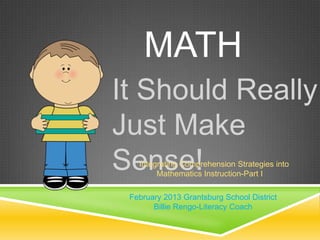
Integrating Comprehension Strategies into Math Instruction
- 1. MATH It Should Really Just Make Sense! Integrating Comprehension Strategies into Mathematics Instruction-Part I February 2013 Grantsburg School District Billie Rengo-Literacy Coach
- 2. COMPREHENSION Comprehension difficulties exist both in reading and in math. Students might appear to understand mathematical operations. Memorization vs. understanding All of our comprehension strategies we use in (Hyde, 2008) (Sammons, 2010) reading can explicitly be taught in math
- 3. MAKING CONNECTIONS KWL Anticipation guides Frayer model Math-to-self connections Math-to-math connections Math-to-world connections Image credit: makingconnectionsgroup.blogspot.com (Sammons, 2010)
- 6. Anticipation guides, described by Laney Sammons in “Guided Math: A Framework for Mathematics Education,” help you assess student prior knowledge and design instruction. (Sammons, 2010)
- 7. Visualizing Visualize to understand the problem Visualize to represent the problem mathematically Every mathematical symbol should be Image credit: teacherweb.com connected to a concrete representation (Hyde, 2008)
- 8. Number Story Example When the Grantsburg Pirates come out onto the court at the beginning of a game, the starting five are announced. Each player slaps a high five to each other player. What is the total number of high fives slapped by the starting five players? Image credit: www.presspubs.com You count one high five when two players slap high fives with each other. (Hyde, 2008)
- 9. K (What do I know?) W (What do I want to C (Are there any find out?) special conditions?) (Hyde, 2008)
- 10. Image credit: An example of a number maplelawndental.com story involving inferring Mrs. Melin’s daughter Alivia just got her first tooth. Mrs. Melin is so glad that she bursts into tears at the very thought of it! In the last complete week, she used up 6 little packets of tissues per day. Each packet had 12 tissues in it. Before solving the problem, create a question to end the story… (Hyde, 2008)
- 11. K (What do I know?) W (What do I want to C (Are there any find out?) special conditions?) (Hyde, 2008)
- 12. PREDICTING Math is the science of patterns 37, 47, 57, ___, ___, 87, ___, ___ ____ + ____=____ Our goal is to teach students to identify and complete patterns Predictions should be based on evidence
- 13. PREDICTING IN PROBABILITY… Scenario: Divide the class up into groups of 3-4 students Each student has a role (supplier, grabber, recorder, and reporter) Image credit: mathcoachblog.wordpress.com Each group is given an index card with a letter S-Z (which is taped to the table) Suppliers come up and get a bag with a letter. The teacher says “Inside your bag are 10 cubes, some red, some blue, some yellow.” (He/she then pulls out one of each color and drops it back in the bag). “You are not to look in the bag. Instead, you must take out 1 cube, record its color, and drop it back in the bag. Do this 25 times. Then analyze your data and predict how many of each color are in the bag.” The group analyzes the results together and the reporter shares the group’s thinking with the class. (Hyde, 2008)
- 14. INFERRING In problem solving, teach students to re- examine their K-W-C to identify inferences (go through it line by line) Inferences can cause inaccuracies (ex. A car travels at an average of 45 mph. A student might infer that it went 45 mph.) (Hyde, 2008)
- 15. PROBLEMS FOR 1ST GRADE Examples of problems that require inferring… 1. Kathy has 17 juicy jelly beans and Lenny has 8. How many more juicy jelly beans does Kathy have than Lenny? 2. Sally has 12 cookies and Kevin has 9. How many fewer does Kevin have than Sally? 3. Mary has 6 Britney Spears CDs. Alice has 3 more than Mary does. How many CDs does Alice have? 4. Henry has 4 Rambo DVDs. He has 2 fewer than Alan does. How many Rambo DVDs does Alan have? 5. Daly has 7 florescent gel-pens. He has 3 more than Laura does. How many florescent gel-pens does Laura have? 6. Danny has 8 markers. Larry has 4 fewer than Danny does. How many markers does Larry have? (Hyde, 2008)
- 16. REFERENCES Hyde, A. A. (2008). Comprehending math, adapting reading strategies to teach mathematics, k-6. Greenwood International. Sammons, L. (2010). Guided math: a framework for mathematics instruction. Huntington Beach, CA: Shell Education.